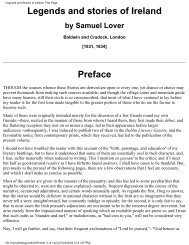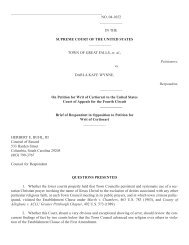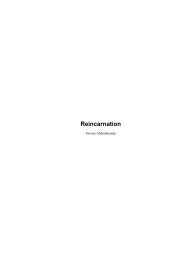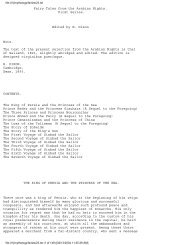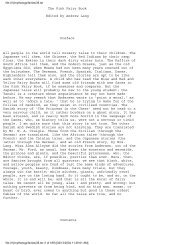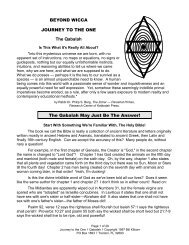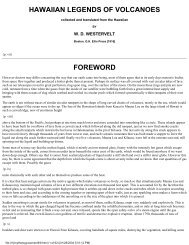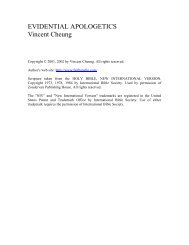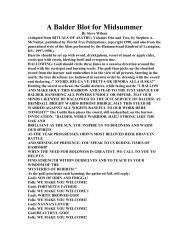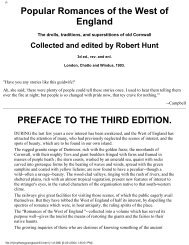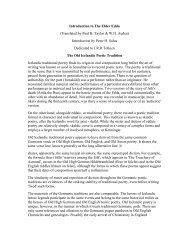Tales and Traditions of the Eskimo - Alternative Religions ...
Tales and Traditions of the Eskimo - Alternative Religions ...
Tales and Traditions of the Eskimo - Alternative Religions ...
You also want an ePaper? Increase the reach of your titles
YUMPU automatically turns print PDFs into web optimized ePapers that Google loves.
<strong>Tales</strong> <strong>and</strong> <strong>Traditions</strong> <strong>of</strong> <strong>the</strong> <strong>Eskimo</strong> - Title Page<br />
angakut being <strong>the</strong> only authority who were acknowledged to derive <strong>the</strong>ir power from <strong>the</strong> supernatural<br />
world, naturally make <strong>the</strong> religious belief a governing principle in <strong>the</strong>ir actions. Their influence, <strong>of</strong><br />
course, at <strong>the</strong> same time, rested upon <strong>the</strong>ir greater intelligence <strong>and</strong> talent. The unshaken faith with which<br />
<strong>the</strong> population regarded <strong>the</strong>ir marvellous deeds cannot be explained except by supposing <strong>the</strong>m to have<br />
had a more pr<strong>of</strong>ound knowledge <strong>of</strong> <strong>the</strong> laws <strong>of</strong> nature, enabling <strong>the</strong>m to form a more accurate conception<br />
than o<strong>the</strong>rs <strong>of</strong> what was likely to happen as regards wea<strong>the</strong>r, hunting, sickness, <strong>and</strong> everything depending<br />
upon physical laws; while as to <strong>the</strong>ir own belief, <strong>the</strong>ir skill in divination most probably was confounded<br />
in <strong>the</strong>ir own fancy with imagined revelations from superior beings. No doubt <strong>the</strong>y <strong>the</strong>mselves relied upon<br />
<strong>the</strong> reality <strong>of</strong> <strong>the</strong>ir supernatural performances, notwithst<strong>and</strong>ing <strong>the</strong> necessity which, on <strong>the</strong> o<strong>the</strong>r h<strong>and</strong>,<br />
<strong>of</strong>ten caused <strong>the</strong>m to act with <strong>the</strong> sole aim <strong>of</strong> more or less consciously deceiving o<strong>the</strong>rs as well as<br />
<strong>the</strong>mselves.<br />
The rules <strong>and</strong> customs concerning property, position, <strong>and</strong> what represented <strong>the</strong> administration <strong>of</strong> justice,<br />
evidently bore a close relation to <strong>the</strong>ir religious belief. The customs according to which an individual<br />
became member <strong>of</strong> a family, partaking <strong>of</strong> its reputation as well as its means <strong>of</strong> subsistence, were<br />
supported <strong>and</strong> confirmed by <strong>the</strong> belief that <strong>the</strong> souls <strong>of</strong> ancestors remained guardian spirits to <strong>the</strong>ir<br />
descendants, having left <strong>the</strong>m <strong>the</strong>ir amulets <strong>and</strong> serrats as a kind <strong>of</strong> pledges. The same ideas must be<br />
regarded as having formed <strong>the</strong> principal foundation for <strong>the</strong> avenging <strong>of</strong> blood.<br />
The social institutions in connection with <strong>the</strong> local conditions leaving still ample room for arbitrary acts<br />
<strong>of</strong> violence, <strong>the</strong> fear <strong>of</strong> vengeance by ghosts, kivigtoks, p. 64 anghiaks, serrats, amulets, <strong>and</strong> tupilaks, must<br />
have powerfully contributed to prevent weak <strong>and</strong> helpless persons being wronged.<br />
By <strong>the</strong> custom <strong>of</strong> naming a child after a deceased person, it was intended to secure rest in his grave for<br />
<strong>the</strong> latter. The child, when grown up, was bound to brave <strong>the</strong> influences which had caused his death. If,<br />
for instance, <strong>the</strong> deceased had perished at sea, his successor had only so much greater an inducement for<br />
striving to grow a skilful kayaker.<br />
The education <strong>of</strong> children was apparently managed without any corporal punishment; but threatening<br />
<strong>the</strong>m with <strong>the</strong> vengeance <strong>of</strong> malevolent spirits, principally <strong>the</strong> kungusotarissat, was one <strong>of</strong> <strong>the</strong> means<br />
employed to keep unruly urchins in check.<br />
The various rules for abstinence in many instances certainly had a direct relation to health.<br />
As to <strong>the</strong> funeral rites, <strong>the</strong> treatment <strong>of</strong> <strong>the</strong> body being considered in some way to influence <strong>the</strong> state <strong>of</strong><br />
<strong>the</strong> soul after death, it was generally placed on <strong>the</strong> floor, for <strong>the</strong> purpose <strong>of</strong> guiding <strong>the</strong> soul on its road to<br />
<strong>the</strong> under world; but in <strong>the</strong> case <strong>of</strong> malefactors, <strong>the</strong> body was dismembered, <strong>and</strong> <strong>the</strong> separate limbs were<br />
thrown apart. O<strong>the</strong>rwise <strong>the</strong> funeral rites differed extremely, <strong>the</strong> Asiatic <strong>Eskimo</strong>, it is said, burning <strong>the</strong>ir<br />
dead, <strong>the</strong> East Greenl<strong>and</strong>ers throwing <strong>the</strong>m into <strong>the</strong> sea; whereas <strong>the</strong> rest <strong>and</strong> greater part <strong>of</strong> <strong>the</strong> nation<br />
buried <strong>the</strong>m beneath a heap <strong>of</strong> stones, or in a kind <strong>of</strong> stone cell.<br />
file:///I|/mythology/american indian/24/24.html (42 <strong>of</strong> 317) [01/24/2004 8:57:49 AM]



